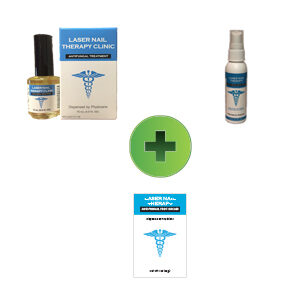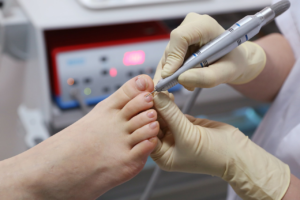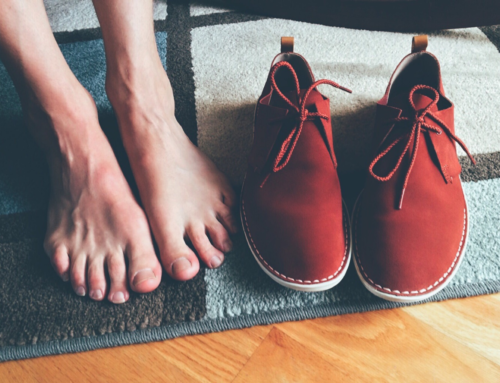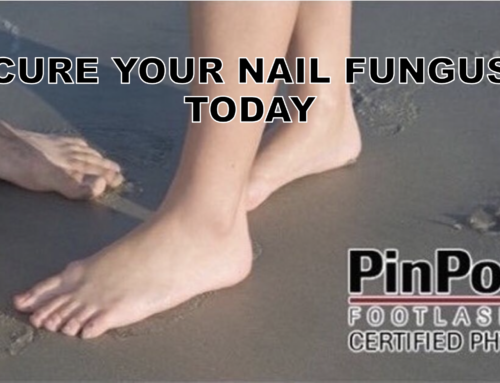Why is toenail fungus hard to get rid of? Toenail fungus is when a fungus begins to develop underneath the nail in the nail bed.
How did I get it?
A lot of toenail fungus occurs because they are made in these environments where there is a lot of moisture and darkness. For example, if someone was sweating on their feet while wearing closed-toed shoes, that allows them to develop the fungus because fungus enjoys those types of environments. At any age, someone can obtain toenail fungus; the most common age of people getting toenail fungus is people over the age of 65. Toenail fungus is when toenails start to become discolored, thick, and break easily. It’s more common for the infection to occur on toenails than on fingernails. The medical term for toenail fungus is “onychomycosis”.
How do I get rid of it?
A lot of people ask the same question, which is why toenail fungus is so hard to get rid of. The issue is that a lot of people have different misconceptions about toenail fungus. Many people believe that the fungus is on the actual nail itself and not underneath the nail. They use topical solutions when, in reality, the medication does not even reach the source of the fungus. The infection is caused by a microscopic organism called a dermatophyte fungus. These infections can be contagious, and they are often difficult to eliminate completely.
Difficulty Cure Fungus
First of all, if you haven’t sought out any treatment for the fungus, that should be your first step. Toenail fungus isn’t a condition that typically heals itself; most patients need to seek out some sort of medical attention. It also makes sense why your fungus isn’t going away if you’ve only been doing at-home treatments like Vicks VapoRub, which aren’t effective at treating the fungus. These aren’t FDA-approved and aren’t performed by a licensed professional.
Treatment Options
Many patients who receive medical attention for their toenail fungus still deal with the condition. Not all medical solutions to fungus are the same; they actually differ significantly in their effectiveness. Some podiatrists will prescribe topical medications for fungus, but these are very weak and have low cure rates. Additionally, these topicals require long periods of application before any improvement is noticed.
Another fairly common prescription is an oral antifungal medication. These do have a higher success rate than topicals, but still are insufficient for a good portion of patients who take them. These oral medications also require a few months of use before results start to show, and can be very toxic to the liver. If your fungus isn’t going away and you’ve only tried these options, there is a better treatment available.

Laser Treatment for Nail Fungus
If you have caught nail fungus, it can be easily treated using the FDA-approved PinPointe laser, which typically only takes one treatment. Other treatments, like topical solutions and oral medication, are not as effective. Topical solutions have a very low cure rate. This is because the solution does not penetrate all the way through the nail bed. This is because it can lead to liver toxicity. You would need to have consistent blood tests throughout the course of taking the medication.
Our nail doctors recommend this treatment for Toenail Fungus. The PinPointe Laser treatment has the highest cure rate in the market. It has no side effects and no recovery period. As a result, you can go about your daily activities right after the treatment. Also, there’s no pain.
Post Laser Treatment
You finally got rid of that embarrassing toenail fungus… or so you thought. But a few months later, it’s back with the same yellow discoloration and thickened nail. It may even appear worse this time.
At Laser Nail Therapy, we see it all the time: people who’ve tried creams, pills, or even previous laser treatments, only to have their fungus return. It’s frustrating and discouraging, but the truth is that recurrent toenail fungus is extremely common. However, with the right treatment and prevention plan, it doesn’t have to keep happening.

Why Does Toenail Fungus Come Back?
There are a few key reasons why toenail fungus often returns:
1. Incomplete Treatment
Many over-the-counter products don’t reach the source of the infection, which lives underneath the nail. So while symptoms may fade temporarily, the fungus is still alive and waiting to grow again.
2. Skipping Aftercare
Even after successful treatment, if you go back to wearing the same shoes or walking barefoot in public places, you’re giving fungus the perfect environment to return.
3. Weakened Nails
Once a nail has been damaged by fungus, it’s more vulnerable to future infections. The structure is compromised, making it easier for fungus to settle in again.
4. The Environment
Fungal spores thrive in warm, moist environments. This includes your shoes, gym locker rooms, nail salons, or communal showers. Without changing some of your habits, it’s easy to get reinfected.
How to Prevent Recurrence
Here’s how you can give your nails the best shot at staying fungus-free:
-
Choose the right treatment. Laser therapy, especially with the PinPointe™ FootLaser®, targets the root of the infection more effectively than creams or oral meds.
-
Disinfect your shoes and socks regularly. Use antifungal sprays or UV sanitizers.
-
Keep feet clean and dry. Change socks daily, and don’t wear the same shoes two days in a row.
-
Avoid going barefoot in public places. Always wear flip-flops or shower shoes.
-
Stick to quality nail salons. Make sure tools are sterilized, or bring your own.
-
Use preventative products. Antifungal sprays and powders can help create a hostile environment for fungus.
Why Patients Trust Laser Nail Therapy
At Laser Nail Therapy, we focus on long-term results, rather than just a quick fix. Our laser treatment not only clears the infection but also significantly lowers the chances of reinfection.
We utilize the PinPointe™ FootLaser®, the leading FDA-cleared laser for treating nail fungus. It’s painless, requires no recovery time, and is designed to destroy the fungus at the source: beneath the nail surface. This allows for results that last.

Call us today at 1-800-672-0625 to schedule your free consultation.
Let us help you break the cycle, for good.




